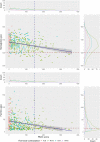Menstrual blood loss is an independent determinant of hemoglobin and ferritin levels in premenopausal blood donors
- PMID: 38856303
- PMCID: PMC11266725
- DOI: 10.1111/aogs.14890
Menstrual blood loss is an independent determinant of hemoglobin and ferritin levels in premenopausal blood donors
Abstract
Introduction: To prevent blood donors from developing iron deficiency (ferritin <15 μg/L) and subsequent anemia (hemoglobin <120 g/L), blood services rely on information about known risk factors, including the donor's sex and age. For example, while Finnish women are able to donate whole blood with a minimum donation interval of 91 days, women in the 18 to 25-year-old age group are recommended to donate no more than once per year. Menstrual blood loss is not accounted for in blood donation interval recommendations, despite being a known risk factor of iron deficiency. We aim to investigate to what extent menstrual bleeding is associated with ferritin and hemoglobin levels in female blood donors, and quantify the association of other menstruation-related variables not currently accounted for by blood services (i.e., use of hormonal contraception, heavy menstrual bleeding) with iron deficiency or anemia.
Material and methods: The study population consisted of 473 premenopausal and 491 postmenopausal Dutch whole blood donors. Exclusion criteria were current pregnancy, BMI ≥50, ferritin ≥200, pictorial blood assessment chart (PBAC) ≥400, and age <18 or ≥70 years. Menstrual blood loss was quantified using a PBAC, a semiquantitative method to evaluate the number of used menstrual products and the degree of staining. We identified predictors of log(ferritin)/hemoglobin and iron deficiency/anemia using Bayesian linear and logistic regression models and quantified the average percentage of variance in log(ferritin) and hemoglobin explained by the covariates.
Results: Menstrual blood loss accounted for most of the explained variance in hemoglobin (8%) and second only to the number of days since last donation for ferritin (8%). Heavy menstrual bleeding (PBAC ≥150, OR = 3.56 [1.45-8.85], prevalence 13%) was associated with anemia, and use of levonorgestrel-releasing intrauterine device was negatively associated with iron deficiency (OR = 0.06 [0.01-0.44]). After statistical control for menstrual blood loss, age was not associated with iron status.
Conclusions: Menstrual blood loss and blood donation were the most important determinants of iron status in premenopausal women. Thus, results suggest that accounting for menstrual blood loss in donation interval guidelines may benefit blood donors.
Keywords: anemia; blood donor health; ferritin; heavy menstrual bleeding; hemoglobin; iron deficiency; menstruation; pictorial blood assessment chart.
© 2024 The Author(s). Acta Obstetricia et Gynecologica Scandinavica published by John Wiley & Sons Ltd on behalf of Nordic Federation of Societies of Obstetrics and Gynecology (NFOG).
Conflict of interest statement
The authors have declared no conflicts of interest.
Figures




Similar articles
-
Iron status in Danish women aged 35-65 years. Relation to menstruation and method of contraception.Acta Obstet Gynecol Scand. 1993 Nov;72(8):601-5. doi: 10.3109/00016349309021150. Acta Obstet Gynecol Scand. 1993. PMID: 8259744
-
Iron status in 268 Danish women aged 18-30 years: influence of menstruation, contraceptive method, and iron supplementation.Ann Hematol. 1998 Jul-Aug;77(1-2):13-9. doi: 10.1007/s002770050405. Ann Hematol. 1998. PMID: 9760147
-
Effectiveness of ferritin-guided donation intervals in whole-blood donors in the Netherlands (FIND'EM): a stepped-wedge cluster-randomised trial.Lancet. 2024 Jul 6;404(10447):31-43. doi: 10.1016/S0140-6736(24)01085-7. Epub 2024 Jun 13. Lancet. 2024. PMID: 38880108 Clinical Trial.
-
Low hemoglobin deferral in blood donors.Transfus Med Rev. 2014 Jan;28(1):18-22. doi: 10.1016/j.tmrv.2013.11.001. Epub 2013 Nov 12. Transfus Med Rev. 2014. PMID: 24332843 Free PMC article. Review.
-
Serum ferritin in Danes: studies of iron status from infancy to old age, during blood donation and pregnancy.Int J Hematol. 1996 Feb;63(2):103-35. doi: 10.1016/0925-5710(95)00426-2. Int J Hematol. 1996. PMID: 8867722 Review.
Cited by
-
Longitudinal assessment of erythrogram parameters in response to granulocytapheresis frequency: A sex-based analysis.Vox Sang. 2025 Mar;120(3):268-276. doi: 10.1111/vox.13788. Epub 2025 Jan 1. Vox Sang. 2025. PMID: 39743343 Free PMC article.
-
Association of hemoglobin with decreased prevalence of diabetic retinopathy among Tibetan male patients.Sci Rep. 2025 Apr 17;15(1):13315. doi: 10.1038/s41598-025-97061-9. Sci Rep. 2025. PMID: 40246958 Free PMC article.
-
Detection of Anemia in Schoolchildren Aged 6-18 Years With Hematocrit Percentile Charts and the Impact of Economic Status in Southern Brazil.Am J Hum Biol. 2025 Apr;37(4):e70034. doi: 10.1002/ajhb.70034. Am J Hum Biol. 2025. PMID: 40165347 Free PMC article.
-
Hormonal contraceptive use and anaemia: a nation-wide pharmacoepidemiological study from Northern Europe.Eur J Epidemiol. 2025 Jul 10. doi: 10.1007/s10654-025-01272-3. Online ahead of print. Eur J Epidemiol. 2025. PMID: 40638010
-
Biochemical differences based on sex and clusters of biomarkers in patients with COVID-19: analysis from the CARDIO COVID 19-20 registry.BMC Cardiovasc Disord. 2025 Mar 5;25(1):147. doi: 10.1186/s12872-025-04565-3. BMC Cardiovasc Disord. 2025. PMID: 40045210 Free PMC article.
References
-
- Peuranpää P, Heliövaara‐Peippo S, Fraser I, Paavonen J, Hurskainen R. Effects of anemia and iron deficiency on quality of life in women with heavy menstrual bleeding. Acta Obstet Gynecol Scand. 2014;93:654‐660. - PubMed
-
- Clement M, Shehu E, Chandler T. The impact of temporary deferrals on future blood donation behavior across the donor life cycle. Transfusion. 2021;61:1799‐1808. - PubMed
-
- Friedman AJ, Chen Z, Ford P, et al. Iron deficiency anemia in women across the life span. J Womens Health (Larchmt). 2012;21:1282‐1289. - PubMed
MeSH terms
Substances
Grants and funding
LinkOut - more resources
Full Text Sources
Medical

